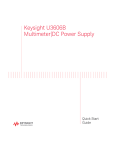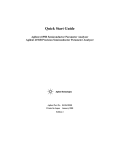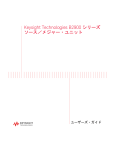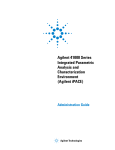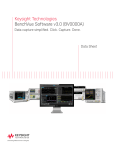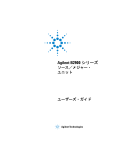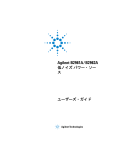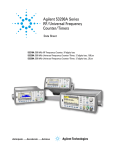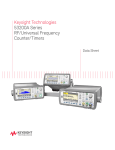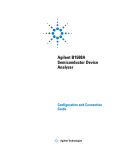Download Agilent Technologies B2902 Technical data
Transcript
Agilent B2900A Series Precision Source/Measure Unit Configuration and Connection Guide Agilent Technologies Notices © Agilent Technologies, Inc. 2011 Manual Part Number No part of this manual may be reproduced in any form or by any means (including electronic storage and retrieval or translation into a foreign language) without prior agreement and written consent from Agilent Technologies, Inc. as governed by United States and international copyright laws. B2900-90090 Edition Edition 1, May 2011 Agilent Technologies, Inc. 5301 Stevens Creek Blvd Santa Clara, CA 95051 USA defined in FAR 2.101(a) or as “Restricted computer software” as defined in FAR 52.227-19 (June 1987) or any equivalent agency regulation or contract clause. Use, duplication or disclosure of Software is subject to Agilent Technologies’ standard commercial license terms, and non-DOD Departments and Agencies of the U.S. Government will receive no greater than Restricted Rights as defined in FAR 52.227-19(c)(1-2) (June 1987). U.S. Government users will receive no greater than Limited Rights as defined in FAR 52.227-14 (June 1987) or DFAR 252.227-7015 (b)(2) (November 1995), as applicable in any technical data. Warranty The material contained in this document is provided “as is,” and is subject to being changed, without notice, in future editions. Further, to the maximum extent permitted by applicable law, Agilent disclaims all warranties, either express or implied, with regard to this manual and any information contained herein, including but not limited to the implied warranties of merchantability and fitness for a particular purpose. Agilent shall not be liable for errors or for incidental or consequential damages in connection with the furnishing, use, or performance of this document or of any information contained herein. Should Agilent and the user have a separate written agreement with warranty terms covering the material in this document that conflict with these terms, the warranty terms in the separate agreement shall control. Technology Licenses The hardware and/or software described in this document are furnished under a license and may be used or copied only in accordance with the terms of such license. Restricted Rights Legend If software is for use in the performance of a U.S. Government prime contract or subcontract, Software is delivered and licensed as “Commercial computer software” as defined in DFAR 252.227-7014 (June 1995), or as a “commercial item” as Open Software License A portion of the software in this product is licensed under terms of the General Public License Version 2 (“GPLv2”). The text of the license and source code can be found at: www.agilent.com/find/GPLV2 Contents 1. B2900A Product Configuration Product Line up of the B2900A Series . . . . . . . . . . . . . . . . . . . . . . . . . . . . . . . . . 1-2 Options of B2900A Series . . . . . . . . . . . . . . . . . . . . . . . . . . . . . . . . . . . . . . . . . . . 1-3 Furnished Accessories . . . . . . . . . . . . . . . . . . . . . . . . . . . . . . . . . . . . . . . . . . . . . . 1-4 2. B2900A Accessories Cables. . . . . . . . . . . . . . . . . . . . . . . . . . . . . . . . . . . . . . . . . . . . . . . . . . . . . . . . . . . 2-2 Adapters & Connectors . . . . . . . . . . . . . . . . . . . . . . . . . . . . . . . . . . . . . . . . . . . . . 2-5 Test Fixture . . . . . . . . . . . . . . . . . . . . . . . . . . . . . . . . . . . . . . . . . . . . . . . . . . . . . . 2-8 N1295A Device/component Test Fixture . . . . . . . . . . . . . . . . . . . . . . . . . . . . . . 2-8 U2941A Test Fixture . . . . . . . . . . . . . . . . . . . . . . . . . . . . . . . . . . . . . . . . . . . . . 2-9 16442B Test Fixture . . . . . . . . . . . . . . . . . . . . . . . . . . . . . . . . . . . . . . . . . . . . . 2-10 Other I/F and Interlock . . . . . . . . . . . . . . . . . . . . . . . . . . . . . . . . . . . . . . . . . . . . 2-11 Rear Panel. . . . . . . . . . . . . . . . . . . . . . . . . . . . . . . . . . . . . . . . . . . . . . . . . . . . . 2-11 Program and Interface Capabilities . . . . . . . . . . . . . . . . . . . . . . . . . . . . . . . . . 2-13 Programming Language . . . . . . . . . . . . . . . . . . . . . . . . . . . . . . . . . . . . . . . . 2-13 Program Memory . . . . . . . . . . . . . . . . . . . . . . . . . . . . . . . . . . . . . . . . . . . . . 2-13 LXI . . . . . . . . . . . . . . . . . . . . . . . . . . . . . . . . . . . . . . . . . . . . . . . . . . . . . . . . 2-13 USB File System. . . . . . . . . . . . . . . . . . . . . . . . . . . . . . . . . . . . . . . . . . . . . . 2-13 Digital I/O Interface . . . . . . . . . . . . . . . . . . . . . . . . . . . . . . . . . . . . . . . . . . . 2-13 Installing the Interlock Circuit . . . . . . . . . . . . . . . . . . . . . . . . . . . . . . . . . . . . . 2-14 Rack Installation . . . . . . . . . . . . . . . . . . . . . . . . . . . . . . . . . . . . . . . . . . . . . . . . . 2-15 3. Connection Connecting to a DUT . . . . . . . . . . . . . . . . . . . . . . . . . . . . . . . . . . . . . . . . . . . . . . . 3-2 “2-wire connections” or “4-wire connections”. . . . . . . . . . . . . . . . . . . . . . . . . . 3-2 Floating. . . . . . . . . . . . . . . . . . . . . . . . . . . . . . . . . . . . . . . . . . . . . . . . . . . . . . . . 3-3 To use Test Leads . . . . . . . . . . . . . . . . . . . . . . . . . . . . . . . . . . . . . . . . . . . . . . . . 3-3 Connection with Test Fixture . . . . . . . . . . . . . . . . . . . . . . . . . . . . . . . . . . . . . . . . . 3-4 To use N1295A Test Fixture. . . . . . . . . . . . . . . . . . . . . . . . . . . . . . . . . . . . . . . . 3-4 To use U2941A Test Fixture. . . . . . . . . . . . . . . . . . . . . . . . . . . . . . . . . . . . . . . . 3-6 To use 16442B Test Fixture . . . . . . . . . . . . . . . . . . . . . . . . . . . . . . . . . . . . . . . . 3-8 Connection with Prober . . . . . . . . . . . . . . . . . . . . . . . . . . . . . . . . . . . . . . . . . . . . 3-12 Connecting to Manual Prober. . . . . . . . . . . . . . . . . . . . . . . . . . . . . . . . . . . . . . 3-12 2-wire (Non-Kelvin) connection. . . . . . . . . . . . . . . . . . . . . . . . . . . . . . . . . . 3-12 4-wire (Kelvin) connection for High Force and High Sense . . . . . . . . . . . . 3-13 4-wire (Kelvin) connection for Low Force and Low Sense . . . . . . . . . . . . . 3-13 Kelvin to non-Kelvin connection . . . . . . . . . . . . . . . . . . . . . . . . . . . . . . . . . 3-14 Agilent B2900A Configuration and Connection Guide, Edition 1 Contents - 1 Contents To make connection to reduce leakage current . . . . . . . . . . . . . . . . . . . . . . . . Guarding . . . . . . . . . . . . . . . . . . . . . . . . . . . . . . . . . . . . . . . . . . . . . . . . . . . . To make connection to measure low resistance . . . . . . . . . . . . . . . . . . . . . . . . Kelvin Connection . . . . . . . . . . . . . . . . . . . . . . . . . . . . . . . . . . . . . . . . . . . . 3-15 3-15 3-16 3-16 4. Ordering Examples Agilent B2900A for Resistance measurement. . . . . . . . . . . . . . . . . . . . . . . . . . . . 4-2 Agilent B2900A for LED IV Measurement . . . . . . . . . . . . . . . . . . . . . . . . . . . . . 4-3 Agilent B2900A for LIV Test of Laser Diode. . . . . . . . . . . . . . . . . . . . . . . . . . . . 4-4 Agilent B2900A for Diode/LED/OLED/Varistor Test . . . . . . . . . . . . . . . . . . . . . 4-5 Agilent B2900A for Characterization of FET & Bipolar Transistor . . . . . . . . . . . 4-6 Agilent B2900A for DC Bias to Network Analyzer . . . . . . . . . . . . . . . . . . . . . . . 4-8 Contents - 2 Agilent B2900A Configuration and Connection Guide, Edition 1 1 B2900A Product Configuration B2900A Product Configuration Product Line up of the B2900A Series 1.1 Product Line up of the B2900A Series The Agilent B2900A Series of Precision Source/Measure Unit provides wider voltage and current coverage, higher resolution, and graphical user interface for more quicker test, debug and characterization on the bench top. The B2900A series consists of four models, the B2901A, B2902A, B2911A and B2912A, differentiated through their measurement specifications and by the number of SMU channels (one or two) they support. This makes it easy to select the exact price/performance point to meet your testing needs. Table 1-1 B2900A Series Ordering Information Item Description B2901A Precision Source/Measure Unit, 1ch, 100 fA, 210 V, 3 A DC/10.5 A pulse B2902A Precision Source/Measure Unit, 2ch, 100 fA, 210 V, 3 A DC/10.5 A pulse B2911A Precision Source/Measure Unit, 1ch, 10 fA, 210 V, 3 A DC/10.5 A pulse B2912A Precision Source/Measure Unit, 2ch, 10 fA, 210 V, 3 A DC/10.5 A pulse Table 1-2 B2900A Series measurement capabilities Effective set and measure value Model Number of SMU channels B2901A 1 B2902A 2 B2911A 1 B2912A 2 Minimum resolution Set Measure 1 pA, 1 V 0.1 pA, 0.1V Maximum current Maximum voltage ± 3.03 A DC, ± 10.5 A Pulse ± 210 V 0.01 pA, 0.1 V NOTE Max number of steps per second and Maximum sample rate are also different between B2901A/B2902A and B2911A/B2912A. For details, refer to the data sheet of the B2900A series. Figure 1-1 Agilent B2912A Precision Source/Measure Unit 10 fA, 2ch 1- 2 Agilent B2900A Configuration and Connection Guide, Edition 1 B2900A Product Configuration Options of B2900A Series 1.2 Options of B2900A Series This section describes Option items of the Agilent B2900A Series Precision Source/Measure Unit. Table 1-3 Option B2900A Options Description OP Instruction Specify the language of the paper manual if you need ABA Paper Manual (User’s Guide), English • Additional printed paper manual. (English) • The B2900A series product includes CD-ROM manuals. ABJ Paper Manual (User’s Guide), Japanese • Additional printed paper manual. (Japanese) • The B2900A series product includes CD-ROM manuals. AB0 Paper Manual (User’s Guide), Traditional Chinese • Additional printed paper manual. (Traditional Chinese) • The B2900A series product includes CD-ROM manuals. AB2 Paper Manual (User’s Guide), Simplified Chinese • Additional printed paper manual. (Simplified Chinese) • The B2900A series product includes CD-ROM manuals. Select calibration options (optional) AJ6 ANSI Z540 compliant calibration • ANSI Z540 compliant calibration UK6 Commercial cal. certificate w/ test data • Test Data for ISO 9001/2 Commercial Calibration. This option provides measurement test data for the standard commercial calibration and test equipment trace information. Select rack mount kit (optional) 1CM Rack mount kit • Rack mount kit for the B2900A series. • 2U height EIA and 1/2 rack width Agilent B2900A Configuration and Connection Guide, Edition 1 1- 3 B2900A Product Configuration Furnished Accessories 1.3 Furnished Accessories The B2900A is furnished with the accessories listed in the following table. Table 1-4 B2900A Options Description Qty. Note Product Reference CD 1 Stores electronic files of user manuals, drivers and software Agilent I/O Libraries CD 1 Stores driver and installation software for the Agilent I/O library Quick Reference 1 Printed reference for quick start (English) Certificate of Calibration (without test data) 1 Certificate of Calibration without test data. If you need the test data, please specify option UK6. USB cable 1 USB cable (1.8 m) The Product Reference CD stores the following software and drivers. • Agilent B2900A Quick I/V Measurement Software - This PC-based software makes it easy to quickly set up and perform IV measurement and to display the measurement data in a table pr graph without any programming. The software allows you to control up to two members of the B2900A series over a GPIB or LAN connection, or one member via a USB connection using furnished USB cable. Operating System: Windows 7 (64bit/32bit), XP SP3 (32bit) Other requirements: Microsoft .NET framework 4.0 or later and Agilent IO Libraries 16.0 or later. 1- 4 • Agilent B2900A Graphical Web Interface - is a web browser based instrument control panel. It enables you to set up and perform a measurement easily and quickly from a web browser using the B2900’s built-in web server. This allows you to control one B2900A series unit over a LAN connection. • IVI-C or IVI-COM drivers - supports Agilent VEE, Microsoft Visual Studio (Visual Basic, Visual C++, Visual C#), National Instrument LabWindows and LabVIEW. It is compatible with Windows 7 (64bit/32bit), XP SP2 (32bit) IO Libraries 16.0 or later. • LabVIEW driver (VI) - National Instruments LabVIEW 7.0 or later. LabVIEW drivers are available at NI.COM. Agilent B2900A Configuration and Connection Guide, Edition 1 2 B2900A Accessories B2900A Accessories Cables 2.1 Cables The B2900A series has banana type output ports with Force, Sense and Guard potential. However, if you use conversion adapter, you can use BNC type cables or Triaxial cables so that each SMU channels can connect to dedicated test environment for DUT such as test fixture or wafer prober. The great variety of available cables can be categorized into mainly five types: Table 2-1 • Banana Test Lead - To simplify the connections, you can use 2-wire connections or 4-wire connections by using banana test leads for connection of DUT. There are many types of DUT interface. • BNC cables - Co-axial type cables. Central signal line is surrounded by shield potential. However, this is not suitable for ultra low current measurement below nA level. For these low current measurements, we recommend to use the following Triaxial cables. • Triaxial cables - have three leads - a central conductor for the signal, an encapsulating conductor that shields the center signal by employing the same voltage thus decreasing a possible leakage current - and an outer conductor that serves as Common. To use this cable, Banana to Triaxial adapter is required. Banana Test Leads for the Agilent B2900A series Model/Option U8201A Description Additional Information Combo Test Lead Kit Couple of test leads, test probes, alligator clips, SMT grabbers, fine-tips test probes, and banana plugs, CAT III 1000 V, 15 A maximum Two kits are required for the 4-wire connections. 11059A Kelvin Probe Set This kelvin probe set consists of two gold-plated flat tweezers with special gripping surfaces. This design assures a very precise contact to the component and very precise measurements. The ground guard connector removes ground-related errors. • Maximum voltage : 42 V • Termination : 5 signal banana plugs (4-wire measurement plus ground) • Cable Length : 0.8 m (31.5 inches) 2-2 Agilent B2900A Configuration and Connection Guide, Edition 1 B2900A Accessories Cables Table 2-2 Model/Option BNC cables for the Agilent B2900A series Description 16493B-001 Coaxial Cable, BNC(m) to BNC(m), 1.5 m 16493B-002 Coaxial Cable, BNC(m) to BNC(m), 3.0 m Additional Information The maximum voltage is 40 V, and Maximum current is 200 mA. The Agilent 16493B Coaxial Cable is designed for use with VSU (Voltage Source Unit), VMU (Voltage Measurement Unit) or PGU (Pulse Generator Unit) on the Agilent 4155 series Semiconductor Parameter Analyzer. 16493U-001 High current coaxial cable, BNC(m) to BNC(m), 1.5 m 16493U-002 High current coaxial cable, BNC(m) to BNC(m), 3.0 m The maximum current is 40 A. The 16493U High current coaxial cable is designed for use with HCSMU (High Current SMU) Module on the Agilent B1505A Power Device Analyzer/Curve Tracer. WARNING Potentially hazardous voltages, up to ±250 V are present at the Force, Sense, and Guard terminals. To prevent electrical shock, do not expose these lines. WARNING Potentially hazardous voltages of up to ±250 V may be present at the Low Force and Low Sense terminals also. To prevent electrical shock, use the accessories comply with the IEC 61010-2-031. The terminals and the extended conductors must be isolated by using the insulation cap, sleeve, and such. WARNING Before turning the B2900A on, connect the Intlk terminal to a switch that turns off when the shielding box access door is opened. Before you touch any connections to these terminals, turn the B2900A off, disconnect the power cable, and discharge any capacitors. CAUTION The 16493B Coaxial Cable is designed for use with VSU (Voltage Source Unit), VMU (Voltage Measurement Unit) or PGU (Pulse Generator Unit) on the Agilent 4155/4156 series. (40 V/200 mA). For the safety reason, Agilent do NOT recommend to use any BNC type cables which have common potential on the connector. CAUTION Never connect the Guard terminal on the B2900A to any output, including circuit common, chassis ground, or any other guard terminal. Doing so will damage the SMU. NOTE Do not put any conductor on the Low Force and Low Sense terminals of each SMU channels, outer conductor of the coaxial connectors, Putting conductor of circuit common, chassis ground, or any potential on causes the measurement error. Agilent B2900A Configuration and Connection Guide, Edition 1 2- 3 B2900A Accessories Cables Table 2-3 Triaxial cables for the Agilent B2900A series Model/Option Description 16494A-001 Triaxial Cable, 1.5 m 16494A-002 Triaxial Cable, 3 m 16494A-003 Triaxial Cable, 80 cm 16494A-004 Triaxial Cable, 40 cm 16494A-005 Triaxial Cable, 4 m Additional Information CAUTION The maximum current rating of the 16494A Triaxial cable is 1A. Do not use the triaxial cable with over 1A. For higher current beyond 1A, It is recommended that U8201A or 11059A with 4-wire connections. NOTE For the lower current measurement, use the 16494A Triaxial cable with low-noise environment. This cable can maximize the guard effects and minimize the impression of the external noise. 2-4 Agilent B2900A Configuration and Connection Guide, Edition 1 B2900A Accessories Adapters & Connectors 2.2 Adapters & Connectors For connecting a DUT, you can choose the connection type 2-wire connection or 4-wire connections. If you want to simplify the connections, use the 2-wire connections by connecting the Force terminals only. Then open the Sense terminals. The Force terminals can be used to apply and measure dc voltage or current. To make the 4-wire connections, remote sensing, well known as Kelvin connections, uses both Force and Sense terminals. Connecting the Force and Sense lines together at the terminal of the DUT minimizes the measurement error caused by the residual resistance of the test leads or cables. This connection is effective for the low resistance measurement and the high current measurement. Before connecting to a DUT, specify suitable connection method on the B2900A series and select required adapters. Figure 2-1 B2900A Front Terminals High Sense, for 4-wire connection High Force Guard Chassis ground Low Force Low Sense, for 4-wire connection Figure 2-2 Simplified SMU Circuit Diagram 2-wire connection + -V +A - High Force Low Force Chassis ground 4-wire connection +A + -V High Force High Sense Low Sense Low Force Chassis ground Agilent B2900A Configuration and Connection Guide, Edition 1 2- 5 B2900A Accessories Adapters & Connectors NOTE The following table shows the adapter information provided by Agilent. If you need and adapter which is not provided, contact a local parts vendor. Table 2-4 Item number information for adapters used with B2900A series Model/Option Description 1253-7217 Plug-Banana Double (black) 1251-2277 Adapter-Banana BNC Jack Plug N1294A-001 Banana to Triaxial adapter for 2 wire (non-kelvin) connection N1294A-002 Banana to Triaxial adapter for 4 wire (kelvin) connection WARNING There are potentially hazardous voltages (210 V) present at the High Force, High Sense, and Guard terminals of Agilent B2900A. To prevent electrical shock, the following safety precautions must be observed during the use of the B2900A. • Use a three-conductor AC power code to connect the cabinet (if used) and the B2900A to an electrical ground (safety ground). • If you do not use the Agilent 16442B Test fixture, you must install and connect an interlock circuit that opens the interlock terminal when the shielding box access door is opened. • Confirm periodically that the interlock function works normally. • Before touching the connections on the High Force, High Sense, and Guard terminals, turn the B2900 off and discharge any capacitors. If you do not turn the B2900 off, complete all of the following items, regardless of the B2900 settings on firm periodically that the interlock function works normally. • 2-6 Additional Information • Press the On/Off key, and confirm that the key turns off. • Confirm that the On/Off key does not turn red. • Open the shielding box access door (open the interlock terminal). • Discharge any capacitors connected to a channel. Warn persons working around the B2900A about dangerous conditions. Agilent B2900A Configuration and Connection Guide, Edition 1 B2900A Accessories Adapters & Connectors CAUTION Maximum voltage and current The test fixture and adapters must be used under the following limitations to prevent damage to them. Agilent N1294A-001 and 002 Banana to Triax adapter: ±250 V maximum, ±42 V maximum for connecting N1295A Small test fixture. Agilent N1295A Small Test Fixture: ±42 V, 1.05 A maximum Figure 2-3 Connection Diagram of N1294A-001 Banana to Triaxial adapter for 2 wire (non-kelvin) connection Figure 2-4 Connection Diagram of N1294A-002 Banana to Triaxial adapter for 4 wire (kelvin) connection Agilent B2900A Configuration and Connection Guide, Edition 1 2- 7 B2900A Accessories Test Fixture 2.3 Test Fixture The Agilent offers the following 3 types of test fixture. Each Test fixture have the specification for maximum voltage and current. For details, refer to the each technical document or user’s guide. • N1295A Device/component Test Fixture - has four triaxial connectors for four terminal devices as maximum. • U2941A Parametric Test Fixture - has three BNC input channels and a common ground. You can select different types of socket modules for device-under-test (DUTs) of various pin conjunctions. • 16442B Test Fixture - designed for testing packaged device and electronic components. You can mount the suitable socket module on the 16442B, which allows you to easily connect various devices to measurement units. 2.3.1 N1295A Device/component Test Fixture The Agilent N1295A is a test fixture which has four triaxial connectors which allows to make two 2-wire connections or the 4-wire connections. To connect to the B2900A, 16494A Triaxial cables and either N1294A-001 or 002 banana to triaxial adapter are required. Table 2-5 N1295A Device/component Test Fixture for the Agilent B2900A series Model/Option N1295A Description Additional Information Device/component Test Fixture The N1295A test fixture furnishes with pin clip wire 4 ea. and pin plug wire 2 ea. CAUTION Maximum voltage and current The test fixture and adapters must be used under the following limitations to prevent damage to them. Agilent N1294A-001 and 002 Banana to Triax adapter: ±250 V maximum, ±42 V maximum for connecting N1295A Small test fixture. Agilent N1295A Small Test Fixture: ±42 V, 1.05 A maximum NOTE Shielding The N1295A is quipped with the lid. To minimize the affect of ambient noise, close the lid when performing the measurement. 2-8 Agilent B2900A Configuration and Connection Guide, Edition 1 B2900A Accessories Test Fixture 2.3.2 U2941A Test Fixture The Agilent U2941A test fixture is designed for semiconductor device testing and has three BNC type input channels and a common guard. You can select different types of socket modules for devices-under-test (DUTs) of various pin conjunctions. To connect to the B2900A, 1253-7217 Plug-Banana Double (black) is required. Table 2-6 U2941A Parametric Test Fixture Model/Option U2941A Description Additional Information Parametric Test Fixture The following items are shipped as standard with the U2941A parametric test fixture. • • • • • • • • • • • • • • U2941A-107 Assembly PTFE plate 28-pin dual-in-package (DIP) socket module 0.1-inch universal socket module 0.075-inch universal socket module 0.5-inch universal socket module Pin plug-to-pin plug cables, black (4 pcs) Pin plug-to-pin plug cables, red (4 pcs) Pin plug-to-pin plug cables, blue (4 pcs) Pin plug-to-miniature clip cables, black (4 pcs) Pin plug-to-miniature clip cables, red (4 pcs) Pin plug-to-miniature clip cables, blue (4 pcs) PCB jumper pin BNC to two-wire cable, 1m (3 pcs) CD-ROM for Agilent Parametric Measurement Manager BNC to two-wire cable (1 m) (U2941-61601) CAUTION The U2941A includes three BNC to two-wire cables. If you need additional cables, select this option. Maximum voltage and current The test fixture and adapters must be used under the following limitations to prevent damage to them. Agilent U2941A Parametric test fixture: ±60 V, 1 A maximum NOTE Shielding The U2941A is quipped with the lid. To minimize the affect of ambient noise, close the lid when performing the measurement. NOTE Ensure that no voltage or current is applied to the U2941A when attaching the socket module. Agilent B2900A Configuration and Connection Guide, Edition 1 2- 9 B2900A Accessories Test Fixture 2.3.3 16442B Test Fixture The Agilent 16442B test fixture is designed for testing packaged devices and electronic components. You can mount the suitable socket module on the 16442B, which allows you to easily connect various devices to measurement units. The 16442B has the following input ports. • 6 SMU channels (Triaxial connector. It can be used either for 6 non-Kelvin or 3 Kelvin connectors.) • 2 VSU channels (BNC connector) • 2 VMU channels (BNC connector) • 2 PGU channels (BNC connector) • 1 GNDU channel (Triaxial connector. It requires the Agilent 16493L GNDU cable.) • 1 interlock 6-pin connector Table 2-7 16442B Test Fixture Model/Option 16442B Description Additional Information Test Fixture for Semiconductor Devices The following items are shipped as standard with the 16442B test fixture. • • • • • • • • • • • • • • • • • • 16442B-010 Blank PTFE board 28-pin dual-in-package (DIP) socket module 0.075-inch universal socket module 0.5-inch universal socket module Miniature banana to pin plug cables, black (4 pcs) Miniature banana to pin plug cables, red (4 pcs) Miniature banana to pin plug cables, blue (4 pcs) Pin plug to pin plug cables, black (3 pcs) Pin plug to pin plug cables, red (3 pcs) Pin plug to pin plug cables, blue (3 pcs) Miniature banana to miniature clip cables, black (3 pcs) Miniature banana to miniature clip cables, red (3 pcs) Miniature banana to miniature clip cables, blue(3 pcs) Miniature banana to miniature banana, black (3 pcs) Miniature banana to miniature banana, red (3 pcs) Miniature banana to miniature banana, blue(3 pcs) Connection pin set (10 ea) Accessory case Add four 1.5 m Triaxial cables (16494A-001) 16442B-011 (16494A-002) NOTE 2-10 Add four 3.0 m Triaxial cables If triaxial cables are required, select either 16442B-001 or 16442B-011. To connect to the B2900A series, N1294A-001 or 002 Banana to Triaxial adapter is required. When the Digital I/O interlock terminal is open, the B2900A cannot apply high voltage over ±42 V. To Perform the high voltage measurement, the B2900A must be connected to the interlock circuit installed in the 16442B. Agilent B2900A Configuration and Connection Guide, Edition 1 B2900A Accessories Other I/F and Interlock 2.4 Other I/F and Interlock 2.4.1 Rear Panel The Agilent B2900A rear panel provides various interfaces. GPIB, USB2.0 and Ethernet (LAN) are used for controlling the B2900A remotely with or without programming. The D-sub 25 pin digital I/O port is general purpose interface. It provides various capabilities used for external control such as trigger input/output, interlock control and handler control signals. It supports to build up a system configured from multiple instruments. The B2900A has the following Interfaces. • GPIB Interface • USB-B Interface • Digital I/O (D-sub 25 pin) • Ethernet (10/100 Bast-T LAN) • Channel 2 terminal (B2902A and B2912A only) CAUTION Never connect the Guard terminal to any output, including circuit common, chassis ground, or any other guard terminal. Doing so will damage the B2900A. CAUTION Maximum current to the chassis ground terminal is 3 A DC. NOTE Serial Number You need the instrument’s serial number when using the Agilent Technologies telephone assistance program. The serial number label is attached to the bottom of the instrument. Figure 2-5 B2912A (2-channel model) Rear View Agilent B2900A Configuration and Connection Guide, Edition 1 2- 11 B2900A Accessories Other I/F and Interlock Figure 2-6 Remote control of B2912A by external PC (through USB/LAN/GPIB) Table 2-8 Item number information for related accessories used with B2900A series Model/Option Description 10833A GBIB cable, 1 m 10833B GBIB cable, 2 m 10833C GBIB cable, 4 m 10833D GBIB cable, 0.5 m 16493G-001 Digital I/O connection cable, 1.5 m 16493G-002 Digital I/O connection cable, 3.0 m N1294A-011 Interlock cable for 16442B Test Fixture, 1.5 m N1294A-012 Interlock cable for 16442B Test Fixture, 3.0 m WARNING 2-12 Additional Information Potentially hazard voltages of up to 210 V may be present at the High Force, High Sense, and Guard terminals when the 16442B test fixture lid is closed. To prevent electrical shock, do not expose these lines. Agilent B2900A Configuration and Connection Guide, Edition 1 B2900A Accessories Other I/F and Interlock 2.4.2 Program and Interface Capabilities Programming Language The B2900A series supports SCPI (Standard Commands for Programmable Instruments). • Default command set: Supports all of the advanced features of the B2900A series • Conventional command set: Support industry standard conventional SCPI command set for basic compatibility. Program Memory Program memory allows you to store long strings of SCPI command lines once into the B2900A series’ volatile memory and then recall those strings multiple times while the program is executing using a single SCPI command. By storing the command strings in memory, the time that would have been spent sending those same commands over a communication bus is eliminated. For tests that utilize lots of repeated code (such as subroutines), program memory can dramatically reduce test times. • Maximum number of characters of program name: 32 with alphabets, numbers, hyphens, and underscores • Maximum memory size: 100 kB (2500 lines typical) LXI LXI Class-C compliant. The B2900A series follows specified LAN protocols and adhere to LXI requirements such as a built-in Web control server and IVI-COM driver. • Ethernet: 10/100Base-T • USB2.0: USB-TMC488 protocol (rear 1) • GPIB: IEEE-488.2 compliant USB File System USB 2.0 high-speed mass storage (MSC) class device (front 1) Digital I/O Interface DSUB 25 pin female connector for general purpose I/O (GPIO). Can be used for the trigger input/output terminals or an interface to a handler and so on. • Connector: 25-pin female D • Input/output pins: 14 open drain I/O bits • Absolute maximum input voltage: 5.25 V • Absolute minimum input voltage: -0.25 V • Maximum logic low input voltage: 0.8 V • Maximum logic high input voltage: 2.0 V • Maximum source current: 1 mA, Vout = 0 V • Maximum sink current: 50 mA, Vout = 5 V Agilent B2900A Configuration and Connection Guide, Edition 1 2- 13 B2900A Accessories Other I/F and Interlock • 5 V power supply pin: Limited to 600 mA, solid state fuse protected • Safety interlock pin: One active high pin and one active low pin. Activation of both pin enables output voltage > 42 V. 2.4.3 Installing the Interlock Circuit The B2900A cannot apply high voltage over ± 42 V when the Digital I/O interlock terminal is open. To perform high voltage measurement, the B2900 interlock terminal must be connected to the interlock circuit installed in the measurement environment such as the shielding box. The interlock circuit is important and necessary to prevent electrical shock when an user touches the measurement terminals. Pin 16 and 24 are reserved for the interlock function. If the terminals are open, the instrument output is limited to ± 42 V. Be sure to connect the terminals to the Agilent 16442B test fixture or another DUT interface before performing measurement. If you do not use the 16442B, you need to install an interlock circuit as shown in Figure 2-7. Please refer to the “Installing the Interlock Circuit” in the Agilent B2900A Series User's Guide for the details. Figure 2-7 An example of Interlock Circuit Shielding box D-sub connector LED Negative or 24, 25 24 15, 19 16, 17 15, 19 Access door Interlock circuit 2-14 14 14 Mechanical switches 17, 18 16 Positive Dsub cable 22, 23 B2900 Digital I/O Agilent B2900A Configuration and Connection Guide, Edition 1 B2900A Accessories Rack Installation 2.5 Rack Installation Agilent B2900A series can be mounted in a 19-inch EIA rack cabinet. It is designed to fit in two rack-units (2U) of space. Remove the handle and the front and rear rubber bumpers before rack mounting the B2900A. Do not block the air intake at the sides and the exhaust at the rear of the B2900A. 1. To Remove the Bumper Stretch a corner of the rubber bumper and slide it off. 2. To Remove the Handle a. Grasp the handle by the sides and pull outward. This allows you to rotate it. b. Rotate the handle to a vertical position. Then put the instrument horizontally. c. Pull outward and then lift the handle upward. c a a b CAUTION To put the handle back again, be careful about its direction. Putting it in the wrong direction may damage it. 3. Attach Rack mount kit. Be sure to use the support rails in the rack cabinet. To rack mount a single instrument, Order an option 1CM on the B2900A series or the Agilent 34190A Rack mount Kit (5063-9240). To rack mount two instruments side-by-side, order the Agilent 34194A Dual lock-link kit (5061-8769) and the 34191A 2U Dual flange kit (5063-9212). CAUTION In order to prevent overheating, do not block the flow of air into or out of the instrument. Be sure to allow enough clearance at the rear, sides, and bottom of the instrument to permit adequate internal air flow. Agilent B2900A Configuration and Connection Guide, Edition 1 2- 15 B2900A Accessories Rack Installation 2-16 Agilent B2900A Configuration and Connection Guide, Edition 1 3 Connection Connection Connecting to a DUT 3.1 Connecting to a DUT This section describes how to connect a device under test (DUT) to the Agilent B2900A series. 3.1.1 “2-wire connections” or “4-wire connections” For connecting a DUT, you can choose the connection type 2-wire connections or 4-wire connections. If you want to simplify the connection, use the 2-wire connections by connecting the Force terminals only. Then open the Sense terminals. The force terminals can be used to apply and measure dc voltage or current. For the low resistance measurement and the high current measurement, use the 4-wire connections. To make the 4-wire connections, remote sensing, well known as the Kelvin connections, use both Force and Sense terminals. Connecting the Force and Sense lines together at the terminal of the DUT minimizes the measurement error caused by the residual resistance of the test leads or cables. Figure 3-1 2-wire and 4-wire connections High Sense High Force High Force SMU DUT Low Force SMU DUT Low Force Low Sense 4-Wire 2-Wire NOTE Kelvin connections (4-wire) give good measurement results when you force high-current, The following figure shows the equivalent circuits for Kelvin and non-Kelvin connections. Figure 3-2 Residual resistance on the Resistance measurement R DUT rF1 R DUT rF2 V rF2 rS1 rS2 V (a) non-Kelvin connection 3- 2 rF1 V (b) Kelvin connection Agilent B2900A Configuration and Connection Guide, Edition 1 Connection Connecting to a DUT 3.1.2 Floating In the default setting, the Low Force and Low Sense terminals are connected to the chassis ground. However, they can be disconnected from the ground fro the floating measurements. This setup is effective for differential voltage measurements which usually require two channels as shown in the Grounded 2 connection. Figure 3-3 Grounded and Floating measurement High Force High Force High Force SMU Low Force SMU DUT High Force DUT Low Force SMU DUT Low Force SMU Low Force Grounded 1 Grounded 2 Floating CAUTION Maximum current to the chassis ground is 3 A DC. WARNING Potentially hazardous voltages of up to ±210 V may be present at the Low Force and Low Sense terminals. To prevent electrical shock, use the accessories comply with the ICE 61010-20-031. The terminals and the extended conductors must be isolated by using the insulation cap, sleeve, etc. 3.1.3 To use Test Leads Type of the B2900A source/measure terminals is the banana jack. For connecting a DUT, the U8201A Combo Test Lead Kit or the 11059A Kelvin Probe Set is available. The following Figure shows the connections for the two-terminal device measurements. Figure 3-4 Connecting a Two-Terminal Device High Sense High Force High Force DUT DUT Low Force Low Force Low Sense 2-wire connections 4-wire connections Agilent B2900A Configuration and Connection Guide, Edition 1 3- 3 Connection Connection with Test Fixture 3.2 Connection with Test Fixture This section describes how to connect with Test Fixture to the Agilent B2900A source/measure terminals. For details of each fixture, refer to the user’s guide of each test fixtures also. 3.2.1 To use N1295A Test Fixture The Agilent N1295A is a test fixture which has four triaxial connectors which supports 2-wire connections. To connect the N1295A to the B2900A source/measure terminals, the Agilent N1294A-001 banana to triaxial adapter for the 2-wire connection is required. • Connection example for two terminals device To connect to the N1295A test fixture for the device of two terminals, two 16494A Triaxial cables are required. Figure 3-5 Agilent N1295A connection example for the device with two terminals 1 Low Force 2 4 3 DUT 1 4 2 3 High Force ± 42V 1.05 A Max • Connection example for three terminals device by 2 channels of SMU To connect to the N1295A test fixture for the device of three terminals such as Bipolar Junction Transistor (BJT), four 16494A Triaxial cables are required. Figure 3-6 3- 4 Connection circuit for BJT (NPN) by 2 channels of SMU Agilent B2900A Configuration and Connection Guide, Edition 1 Connection Connection with Test Fixture Figure 3-7 Agilent N1295A connection example for the BJT (NPN) by 2 channels of SMU Low Force ch 1 Low Force ch 2 High Force ch 1 High Force ch 2 Emitter Collector CAUTION Base Maximum voltage and current The test fixture and adapters must be used under the following limitations to prevent damage to them. Agilent N1294A-001 Banana to Triax adapter: ±250 V maximum, ±42 V maximum for connecting N1295A Small test fixture. Agilent N1295A Small Test Fixture: ±42 V, 1.05 A maximum NOTE Shielding The N1295A is quipped with the lid. To minimize the affect of ambient noise, close the lid when performing the measurement. NOTE 4-wire connections are not supported on the N1295A and B2900A. Agilent B2900A Configuration and Connection Guide, Edition 1 3- 5 Connection Connection with Test Fixture 3.2.2 To use U2941A Test Fixture The Agilent U2941A test fixture is designed for semiconductor device testing and has three BNC type input channels and a common guard. You can select different types of socket modules for devices-under-test (DUTs) of various pin conjunctions. See Agilent U2941A Parametric Test Fixture Operating Guide for details and accessories of the U2941A. To connect to the B2900A source/measure terminals, 1253-7217 Plug-Banana Double (black) is required. • Connection example for 2-wire Connections To connect to the U2941A test fixture for 2-wire connections, one BNC to two-wire cable (U2941-61601) and one Plug-Banana Double adapter (1253-7217) are required. Attach the plug-banana double adapter to High Force and Low Force terminals on the B2900A Channel 1 terminal. Figure 3-8 Agilent U2941A connection example for 2-wire connections B2900A Channel 1 High Sense High Force 1253-7217 Plug-Banana Double (Black) U2941A Input Port 1 BNC male inner contact (RED) Guard Output + Low Sense Low Force Sense + U2941-61601 BNC to two-wire cable Chassis Ground Guard GND Output - BNC male outer contact (BLACK) Sense - Figure 3-9 U2941A Wiring Panel + Output Guard Sense 1 - + Output Output Sense Sense Guard - + Force Output Guard Sense 2 SMU(± 60V= 1A Max) Guard Output Sense 3 DUT 2-wire connections 3- 6 Agilent B2900A Configuration and Connection Guide, Edition 1 Connection Connection with Test Fixture • Connection example for 4-wire Connections To connect to the U2941A test fixture for 4-wire connections, two BNC to two-wire cable (U2941-61601) and two Plug-Banana Double adapter (1253-7217) are required. Attach the plug-banana double adapters to the B2900A source/measure terminals (High Force, Low Force, Low Force and Low Sense) as shown in the following figure. Figure 3-10 Agilent U2941A connection example for 4-wire connections B2900A Channel 1 1253-7217 Plug-Banana Double (Black) U2941A Input Port 1 BNC male inner contact (RED) High Force Output + High Sense Sense + Guard BNC male outer contact (BLACK) Guard GND Output Sense - BNC male inner contact (RED) Low Force Chassis Ground U2941-61601 BNC to two-wire cable Low Sense BNC male outer contact (BLACK) Figure 3-11 U2941A Wiring Panel + Output Guard Sense 1 - + Output Output Sense Sense Guard - + Force Output Guard Sense 2 SMU(± 60V= 1A Max) Guard Output Sense 3 DUT 4-wire connections WARNING Dangerous voltage of up to the maximum voltage of SMUs may be present at force, guard and sense terminals if the Interlock terminal is closed. WARNING To avoid electrical shock and instrument damage, do not connect or disconnect measurement cable during operation. Agilent B2900A Configuration and Connection Guide, Edition 1 3- 7 Connection Connection with Test Fixture 3.2.3 To use 16442B Test Fixture The Agilent 16442B test fixture is designed for testing packaged devices and electronic components. The 16442B has six triaxial connectors for source/measure unit (SMU), the GNDU connector for the ground unit of a parameter/device analyzer, the Interlock connector for the interlock control, and six coaxial (BNC type) connectors for other instruments. You can mount the suitable socket module on the 16442B, which allows you to easily connect various devices to measurement units. See Agilent 16442B Test Fixture User’s Guide for details and accessories of the 16442B. To connect to the B2900A source/measure terminals, N1294A-001 or 002 Banana to Triaxial adapter is required. • Connection example for 2-wire Connections To connect to the 16442B test fixture for 2-wire connections, N1294A-001 banana to triaxial adapter for 2 wire (non-kelvin) connection and two 16494A triaxial cables are required. Attach the banana to triaxial adapter to the B2900A source/measure terminals. Connect the triaxial cables between the adapter and the 16442B as shown in the following figure. Figure 3-12 Agilent 16442B connection example for 2-wire connections Low Force N1294A-001 Adapter for the 2-wire connections High Force N1294A-011 or 012 Interlock cable for 16442B 1 1 1 Low Force to SMU 2 2 2 VSU GNDU High Force to SMU 1 2 1 3 2 4 VMU 3 1 5 16494A Triaxial Cable Figure 3-13 PGU SMU Interlock 2 6 16442B Test Fixture 16442B Wiring Panel (2-wire connections) SMU(±200V= 1A Max) 1 2 3 (Selected) Force Sense Force Sense Force Sense Guard Guard Guard Guard Guard Guard DUT 2-wire connections 3- 8 Agilent B2900A Configuration and Connection Guide, Edition 1 Connection Connection with Test Fixture • Connection example for 4-wire Connections To connect to the 16442B test fixture for 4-wire connections, N1294A-002 banana to triaxial adapter for 4 wire (kelvin) connection and three 16494A triaxial cables are required. Attach the banana to triaxial adapter to the B2900A source/measure terminals. Connect the triaxial cables between the adapter and the 16442B as shown in the following figure. Figure 3-14 Agilent 16442B connection example for 4-wire connections High Sense N1294A-002 Adapter for the 4-wire connections High Force N1294A-011 or 012 Interlock cable for 16442B Interlock 1 1 2 2 1 Low Force/Low Sense to GNDU VSU GNDU 2 1 2 4 3 VMU High Sense to SMU 2 3 1 High Force to SMU 1 16494A Triaxial Cable 2 6 5 Figure 3-15 PGU SMU Low Force/ Low Sense 16442B Test Fixture 16442B Wiring Panel (4-wire connections) GNDU SMU(±200V= 1A Max) 1 2 3 (Selected) Force Sense Force Sense Force Sense Force Guard Guard Guard Guard Guard Guard Sense DUT 4-wire connections Agilent B2900A Configuration and Connection Guide, Edition 1 3- 9 Connection Connection with Test Fixture • Connection example for three terminals device by 2 channels of SMU To connect to the 16442B test fixture for three terminals device by 2 channels of SMU, two sets of N1294A-001 banana to triaxial adapter for 2 wire (non-kelvin) connection and four 16494A triaxial cables are required. Attach the banana to triaxial adapter to the B2900A source/measure terminals. Connect the triaxial cables between the adapter and the 16442B as shown in the following figure. Figure 3-16 Agilent 16442B connection example for three terminals device by 2 SMUs Low Force (Ch 1) to SMU 2 High Force (Ch 1) to SMU 1 Channel 1 Interlock 1 1 N1294A-011 or 012 Interlock cable for 16442B Channel 2 PGU SMU 16494A Triaxial Cable 1 VSU GNDU 2 1 3 Low Force (Ch 2) to SMU 4 VMU 1 5 Figure 3-17 2 4 3 N1294A-001 Adapter for the 2-wire connections 2 2 2 6 High Force (Ch 2) to SMU 3 16442B Test Fixture 16442B Wiring Panel (BJT (NPN) by 2 channels of SMU) SMU(±200V= 1A Max) 1 2 3 (Selected) Force Sense Force Sense Force Sense Guard Guard Guard Guard Guard Guard Collector Emitter Base Connections for BJT (NPN) CAUTION Maximum voltage and current The test fixture and adapters must be used under the following limitations to prevent damage to them. Agilent N1294A-001 and 002 Banana to Triax adapter: ±250 V maximum, ±200 V maximum for connecting 16442B test fixture. Agilent 16442B Test Fixture: ±200 V, 1 A maximum for SMU input 3- 10 Agilent B2900A Configuration and Connection Guide, Edition 1 Connection Connection with Test Fixture NOTE Shielding The 16442B is quipped with the lid. To minimize the affect of ambient noise, close the lid when performing the measurement. NOTE Performing high voltage measurement When the Digital I/O interlock terminal is open, the B2900A cannot apply high voltage over ±42 V. To perform the high voltage measurement, the B2900A must be connected to the interlock circuit installed in the 16442B. Prepare the N1294A-011 or 012 interlock cable. And connect it between the B2900A Digital I/O connector and the 16442B Interlock connector. The B2900A can apply the high voltage when the test fixture lid is closed. WARNING Potentially hazardous voltages of up to ±210 V may be present at the High Force, High Sense, and Guard terminals when the 16442B test fixture lid is closed. To prevent electrical shock, do not expose these lines. Agilent B2900A Configuration and Connection Guide, Edition 1 3- 11 Connection Connection with Prober 3.3 Connection with Prober This section describes information on how to connect a prober to the B2900A series Precision Source / Measure Unit. 3.3.1 Connecting to Manual Prober High Force and Low Force terminal on the N1294A-001 banana to triaxial adapter for 2-wire have FORCE (SENSE), GUARD, and COMMON output as shown Figure 3-18. High Force and High Sense on the he N1294A-002 banana to triaxial adapter for 4-wire also have same output terminals as shown Figure 3-18. However, Low Force and Low Sense of the N1294A-002 banana to triaxial adapter for 4-wire have SENSE, FORCE, and COMMON as shown in Figure 3-19. Figure 3-18 High Force, High Sense and Low Force of N1294A-001 Figure 3-19 Low Force & Low Sense terminals on the N1294A-002 2-wire (Non-Kelvin) connection These instructions apply when all connections are 2-wire (non-Kelvin) connection for wafer prober. Connect the Agilent 16494A triaxial cables between the N1294A-001 banana to triaxial adapter for 2-wire on the B2900A and the Connector plate. Connect the triaxial connector on the probe cable as shown in Figure 3-20. Figure 3-20 Example of 2-wire (non-Kelvin) connection Shielding box N1294A Low Force Probe cable (triaxial) Prober High Force Triaxial cable 16494A-001 1.5m or 16494A-002 3.0m 3- 12 DUT Connector plate Agilent B2900A Configuration and Connection Guide, Edition 1 Connection Connection with Prober 4-wire (Kelvin) connection for High Force and High Sense These instructions apply when all connections are Kelvin. Two probes must contact the wafer in this connection. Connect two Agilent 16494A triaxial cables between the High Force and High Sense Terminals on the N1294A-002 banana to triaxial adapter for 4-wire and the connector plate. Connect the FORCE and SENSE lines to probes separately. Connect the triaxial connector on the probe cable as shown in Figure 3-21. NOTE To prevent oscillations, use triaxial cables as short as possible, if two 16494A triaxial cables with Kelvin connections are used. Figure 3-21 Example of 4-wire (Kelvin) connection for High Force and High Sense Shielding box N1294A-002 Low Force/Low Sense High Force Probe cable (triaxial) Prober Probe cable (triaxial) High Sense Triaxial cable 16494A-001 1.5m or 16494A-002 3.0m DUT Connector plate 4-wire (Kelvin) connection for Low Force and Low Sense Connect the triaxial connector using an adapter for GNDU (N1254A-107) as shown in Figure 3-22. This adapter connects Force Terminal and Sense Terminal to the center conductor. For parts information for this connection, see Table 3-1. Figure 3-22 Example of 4-wire (Kelvin) connection for Low Force and Low Sense Shielding box Triaxial cable 16494A-001 1.5m or 16494A-002 3.0m Adapter for GNDU N1254A-107 N1294A-002 Low Force/Low Sense Probe cable (triaxial) Prober High Force Connector plate DUT High Sense Agilent B2900A Configuration and Connection Guide, Edition 1 3- 13 Connection Connection with Prober Item number information for 4-wire (Kelvin) connection for the Low terminal Table 3-1 Description Qty Product Number Part number Triaxial Cable (1.5 m) - Max 1.0 A 1 16494A-001 N/A Triaxial Cable (3.0 m) - Max 1.0 A 1 16494A-002 N/A Triax (m) to Triax (f) adapter 1 N1254A-107 1250-2654 Kelvin to non-Kelvin connection These instructions apply when the connections up to the Connector Plate are Kelvin, but the probe is a non-Kelvin connection. Connect two Agilent 16494A triaxial cables between the N1294A-002 banana to triaxial adapter for 4-wire and the connector plate. Connect the triaxial connector on the probe cable as shown in Figure 3-23. Connect the FORCE and SENSE lines on this side of the probe input terminal. A Tee Triaxial BNC adapter can be used. For parts information, see Table 3-2. NOTE To prevent oscillations, use triaxial cables as short as possible, if two 16494A triaxial cables with Kelvin connections are used. NOTE When connecting the cable and tee connector as shown in Figure 3-23, space restrictions make an adjacent connector unusable. Since three connectors are necessary for a Kelvin connection a connector plate must be used. Select the correct connector plate for your application. Figure 3-23 Example of Kelvin to non-Kelvin connection Shielding box N1294A-002 Low Force/ Low Sense Probe cable (triaxial) High Force Tee triaxial BNC 1250-1551 DUT Triaxial cable 16494A-004 0.4m High Sense Triaxial cable 16494A-001 1.5m or 16494A-002 3.0m Table 3-2 Prober Connector plate Item number information for Kelvin to non-Kelvin connection with B2900A Description Qty Product Number Part number Triaxial Cable (1.5 m) - Max 1.0 A 2 16494A-001 N/A Triaxial Cable (3.0 m) - Max 1.0 A 2 16494A-002 N/A Triaxial Cable (0.4 m) 1 16494A-004 N/A Triaxial tee-connector 1 N/A 1250-1551 3- 14 Agilent B2900A Configuration and Connection Guide, Edition 1 Connection Connection with Prober 3.3.2 To make connection to reduce leakage current To reduce the leakage current caused by connection cables, the guard technique is effective. Connect the probing needles to the coaxial cables as shown below: Guarding reduces the leakage current between the instrument and a DUT. This is important when you measure low current. 1. Cut and trim end of the coaxial cable so that the center conductor does not touch the outer conductor (connected to the guard terminal). 2. Connect the center conductor to tail of the probing needle. Never connect the outer conductor to the probing needle. However, the outer conductor should be extended as close as possible to the probing needle. 3. Connect the outer conductor to the outer conductor of the probing needle if it is a coaxial probing needle. The following example connection can be used to reduce the leakage current. Extend the outer conductor as close as possible to the probing needle, This is also reduces the induced noise. Figure 3-24 Cable and Probing needle Center conductor Outer conductor Coaxial cable Connector plate Probing needle Contact pad Guarding Guarding reduces the leakage current between the instrument and the measurement point. This is important when you measure low current. The following figure shows the theory of guarding. The buffer amplifier (1) keeps the potential of the guard conductor at the same potential as the force conductor, so current does not flow between the force and guard conductors. Therefore, the current measured by the instrument is same as current at the DUT terminal because no current is leaked. Figure 3-25 Guarding A Guard Force DUT Buffer Agilent B2900A Configuration and Connection Guide, Edition 1 3- 15 Connection Connection with Prober 3.3.3 To make connection to measure low resistance When you measure a low resistance, high current flows through the DUT. This high current increases the measurement error caused by the residual resistance of cables. To cancel the effect of this resistance, you can use Kelvin connections (4-wire), which means the Force and Sense lines are extended separately to the DUT. Connect the probing needles to the coaxial cables as shown below: 1. Cut and trim end of the coaxial cable so that the center conductor does not touch the outer conductor (connected to the guard terminal). 2. Connect the center conductor to tail of the probing needle. Never connect the outer conductor to the probing needle. However, the outer conductor should be extended as close as possible to the probing needle. 3. Connect the outer conductor to the outer conductor of the probing needle if it is a coaxial probing needle. 4. Perform 1 to 3 for both Force and Sense lines. 5. Contact the probing needles for the Force and Sense lines as close as possible to the DUT. The following example connection can be used to measure low resistance. The Sense line is extended to the probing pad, and contacts the Force line through the pad, so the voltage drop due to the residual resistance caused by cables and test leads is canceled. Figure 3-26 Cable and Probing needle Center conductor Outer conductor Force Probing needle Sense Contact pad Coaxial cable Connector plate Contact pad Kelvin Connection Kelvin connections give good measurement results when you force high-current. The following figure shows the equivalent circuits for Kelvin and non-Kelvin connections. Figure 3-27 Kelvin connection R DUT rF1 R DUT rF2 V rF2 rS1 rS2 V (a) non-Kelvin connection 3- 16 rF1 V (b) Kelvin connection Agilent B2900A Configuration and Connection Guide, Edition 1 Connection Connection with Prober • For the non-Kelvin connection, the voltmeter measures the voltage drop of resistance rF1,RDUT, and rF2. • For the Kelvin connection, the voltmeter measures the voltage drop of resistance RDUT only. The impedance of the voltmeter is very high, so the voltage drop of resistances rS1 and rS2 can be ignored. The Kelvin connection is effective even when forcing voltage. The voltage drop due to the residual resistance of the Force line wiring is fed back to the voltage source via a comparator in the Sense line. The input impedance of comparator is high, and current flow into the Sense line is very low. So output error is not significant if the Sense line wiring has a residual resistance of 10 or less. Therefore, the specified voltage appears at the sense point (point where Sense line contacts Force line). WARNING Do not touch the guard terminal with bare hands because you may be shocked by high voltage. The potential of the guard terminal is equal to the output voltage. CAUTION Never connect the Guard terminal to any other output, including circuit common, chassis ground, or any other guard terminal. Doing so will damage the B2900A. NOTE Kelvin connection and non-Kelvin connection To make the Kelvin connection, use both Force and Sense terminals. Connecting the Force and Sense lines together at the terminal of the DUT (device under test) minimizes the measurement error caused by the residual resistance of the connection cables. The Kelvin connection is effective for the low resistance measurement and the high current measurement. If you want to simplify the cable connections, use the 2-wire connections by connecting the Force terminals only. Then open the Sense terminals. This is the non-Kelvin connection. The Force terminals can be used to force and measure dc voltage or current. Agilent B2900A Configuration and Connection Guide, Edition 1 3- 17 Connection Connection with Prober 3- 18 Agilent B2900A Configuration and Connection Guide, Edition 1 4 Ordering Examples Ordering Examples Agilent B2900A for Resistance measurement 4.1 Agilent B2900A for Resistance measurement Making accurate resistance measurements is actually one of the more challenging areas of measurement science. Many factors can affect the accuracy of a resistance measurement, including residual test lead resistance, thermal electromotive force and leakage currents in the measurement path. The B2900A Series possesses a variety of features to address these measurement issues, including a remote sense function (4-wire connection), offset compensation, and a guard function. For details, refer to the Technical Overview, Resistance Measurement by B2900A (5990-6633EN). Table 4-1 Model/Option Agilent B2901A with basic test leads (2-wire connections) Quantity Description B2901A 1 Precision Source/Measure Unit, 1ch, 100 fA, 210 V, 3 A DC/10.5A pulse U8201A 1 Combo Test Lead Kit Table 4-2 Model/Option Agilent B2901A with basic test leads (4-wire connections) Quantity Description B2901A 1 Precision Source/Measure Unit, 1ch, 100 fA, 210 V, 3 A DC/10.5 A pulse 11059A 1 Kelvin Probe Set Table 4-3 Model/Option Agilent B2901A with U2941A Test Fixture (4-wire connections) Quantity Description B2901A 1 Precision Source/Measure Unit, 1ch, 100 fA, 210 V, 3 A DC/10.5 A pulse 1253-7217 2 Plug-Banana Double (black) U2941A 1 Parametric Test Fixture Table 4-4 Model/Option Agilent B2901A with 16442B Test Fixture (4-wire connections) Quantity Description B2901A 1 Precision Source/Measure Unit, 1ch, 100 fA, 210 V, 3 A DC/10.5 A pulse N1294A-002 1 Banana to Triaxial adapter for 4 wire (kelvin) connection 16442B 1 Test Fixture for Semiconductor Devices 16494A 3 Triaxial Cable N1294A-011 (012) 1 Interlock cable for 16442B Test Fixture, 1.5 m (3.0 m) NOTE 4- 2 16494A triaxial cable has several options for cable length. Specify cable option and quantity. Agilent B2900A Configuration and Connection Guide, Edition 1 Ordering Examples Agilent B2900A for LED IV Measurement 4.2 Agilent B2900A for LED IV Measurement The energy efficiencies and durability of light emitting diodes (LEDs) have led to their increased usage in a variety of applications such as lighting, display panels, etc. This has also spawned research into new types of LEDs with even higher energy efficiencies and properties tailored for specific applications. The B2900A Series enables you to make a wide range of current versus voltage (IV) measurements more accurately and quickly. Table 4-5 Model/Option Agilent B2911A with N1295A small test fixture (2-wire connections) Quantity Description B2911A 1 Precision Source/Measure Unit, 1ch, 10 fA, 210 V, 3 A DC/10.5 A pulse N1294A-001 1 Banana to Triaxial adapter for 2 wire (non-kelvin) connection N1295A 1 Device/component Test Fixture 16494A 2 Triaxial Cable Table 4-6 Model/Option Agilent B2911A with 16442B Test Fixture (2-wire connections) Quantity Description B2911A 1 Precision Source/Measure Unit, 1ch, 10 fA, 210 V, 3 A DC/10.5 A pulse N1294A-001 1 Banana to Triaxial adapter for 2 wire (non-kelvin) connection 16442B 1 Test Fixture for Semiconductor Devices 16494A 2 Triaxial Cable Table 4-7 Model/Option Agilent B2911A and accessories for Manual Prober (2-wire connections) Quantity Description B2911A 1 Precision Source/Measure Unit, 1ch, 10 fA, 210 V, 3 A DC/10.5 A pulse N1294A-001 1 Banana to Triaxial adapter for 2 wire (non-kelvin) connection 16494A 2 Triaxial Cable Table 4-8 Model/Option Agilent B2911A and accessories for Manual Prober (4-wire connections) Quantity Description B2911A 1 Precision Source/Measure Unit, 1ch, 10 fA, 210 V, 3 A DC/10.5 A pulse N1294A-002 1 Banana to Triaxial adapter for 4 wire (non-kelvin) connection 16494A 3 Triaxial Cable NOTE 16494A triaxial cable has several options for cable length. Specify cable option and quantity. Agilent B2900A Configuration and Connection Guide, Edition 1 4- 3 Ordering Examples Agilent B2900A for LIV Test of Laser Diode 4.3 Agilent B2900A for LIV Test of Laser Diode The light-current-voltage (LIV) sweep test is a fundamental measurement to determine the operating characteristics of a laser diode (LD). In the LIV test, current applied to the laser diode is swept and the intensity of the resulting emitted light is measured using a photo detector (PD). The B2902A and B2912A have two SMU channels, and each channel possesses accurate IV measurement capabilities as well as the ability to supply either constant or swept voltage/current. The B2902A and B2912A excellent choices for laser diode LIV testing. For details, refer to the Technical Overview, LIV Test of Laser Diode by B2900A (5990-7115EN). Table 4-9 Model/Option Agilent B2902A with N1295A small test fixture (2-wire connections) Quantity Description B2902A 1 Precision Source/Measure Unit, 2ch, 100 fA, 210 V, 3 A DC/10.5 A pulse N1294A-001 2 Banana to Triaxial adapter for 2 wire (non-kelvin) connection N1295A 1 Device/component Test Fixture 16494A 4 Triaxial Cable Table 4-10 Model/Option Agilent B2902A with 16442B Test Fixture (2-wire connections) Quantity Description B2902A 1 Precision Source/Measure Unit, 2ch, 100 fA, 210 V, 3 A DC/10.5 A pulse N1294A-001 2 Banana to Triaxial adapter for 2 wire (non-kelvin) connection 16442B 1 Test Fixture for Semiconductor Devices 16494A 4 Triaxial Cable N1294A-011 (012) 1 Interlock cable for 16442B Test Fixture, 1.5 m (3.0 m) NOTE 4- 4 16494A triaxial cable has several options for cable length. Specify cable option and quantity. Agilent B2900A Configuration and Connection Guide, Edition 1 Ordering Examples Agilent B2900A for Diode/LED/OLED/Varistor Test 4.4 Agilent B2900A for Diode/LED/OLED/Varistor Test To ensure compliance with manufacturing specifications, single-point pass/fail DC testing must be performed on packaged devices. Because these tests are also used to identify and remove defective devices before shipment, their reliability is important to guarantee product quality. In addition, it is also essential to perform the tests quickly to keep the production throughput high. The B2900A Series also has many features that make it well-adapted for production test, such as pass/fail binning, a digital I/O interface for handler control, and code compatibility with standard single channel SMU products. Table 4-11 Model/Option Agilent B2901A and accessories for production test (1 channel) Quantity Description B2901A 1 Precision Source/Measure Unit, 1ch, 100 fA, 210 V, 3 A DC/10.5 A pulse N1294A-001 1 Banana to Triaxial adapter for 2 wire (non-kelvin) connection 16494A 2 Triaxial Cable 16493G 1 Digital I/O connection cable Table 4-12 Model/Option Agilent B2902A and accessories for production test (2 channels) Quantity Description B2902A 1 Precision Source/Measure Unit, 2ch, 100 fA, 210 V, 3 A DC/10.5 A pulse N1294A-001 2 Banana to Triaxial adapter for 2 wire (non-kelvin) connection 16494A 4 Triaxial Cable 16493G 1 Digital I/O connection cable NOTE 16494A triaxial cable and 16493G Digital I/O cable have several options for cable length. Specify cable option and quantity. Agilent B2900A Configuration and Connection Guide, Edition 1 4- 5 Ordering Examples Agilent B2900A for Characterization of FET & Bipolar Transistor 4.5 Agilent B2900A for Characterization of FET & Bipolar Transistor An SMU combines the capabilities of a current source, a voltage source, a current meter and a voltage meter along with the capability to switch easily between these various functions into a single instrument. This gives it the ability to evaluate the IV characteristics of devices across all four measurement quadrants without the need for any additional equipment. Besides being able to output and measure voltage or current very accurately, SMUs also possess a compliance feature that allows a limit to be placed on the voltage or current output to prevent device damage. Evaluation of FET or bipolar transistor requires applying different voltages and currents with the constant or the sweep condition to the gate and the drain terminal respectively in order to acquire the several parameters and characteristics. Table 4-13 Model/Option Agilent B2902A with N1295A small test fixture (2-wire connections) Quantity Description B2912A 1 Precision Source/Measure Unit, 2ch, 10 fA, 210 V, 3 A DC/10.5 A pulse N1294A-001 2 Banana to Triaxial adapter for 2 wire (non-kelvin) connection N1295A 1 Device/component Test Fixture 16494A 4 Triaxial Cable Table 4-14 Model/Option Agilent B2902A with 16442B Test Fixture (2-wire connections) Quantity Description B2912A 1 Precision Source/Measure Unit, 2ch, 10 fA, 210 V, 3 A DC/10.5 A pulse N1294A-001 2 Banana to Triaxial adapter for 2 wire (non-kelvin) connection 16442B 1 Test Fixture for Semiconductor Devices 16494A 4 Triaxial Cable N1294A-011 (012) 1 Interlock cable for 16442B Test Fixture, 1.5 m (3.0 m) Table 4-15 Model/Option Agilent B2902A with 16442B Test Fixture (4-wire connections for 1 channel) Quantity Description B2912A 1 Precision Source/Measure Unit, 2ch, 10 fA, 210 V, 3 A DC/10.5 A pulse N1294A-001 1 Banana to Triaxial adapter for 2 wire (non-kelvin) connection N1294A-002 1 Banana to Triaxial adapter for 4 wire (kelvin) connection 16442B 1 Test Fixture for Semiconductor Devices 16494A 5 Triaxial Cable N1294A-011 (012) 1 Interlock cable for 16442B Test Fixture, 1.5 m (3.0 m) 4- 6 Agilent B2900A Configuration and Connection Guide, Edition 1 Ordering Examples Agilent B2900A for Characterization of FET & Bipolar Transistor Table 4-16 Model/Option Agilent B2912A and accessories for Manual Prober (2-wire connections) Quantity Description B2912A 1 Precision Source/Measure Unit, 2ch, 10 fA, 210 V, 3 A DC/10.5 A pulse N1294A-001 2 Banana to Triaxial adapter for 2 wire (non-kelvin) connection 16494A 4 Triaxial Cable Table 4-17 Model/Option Agilent B2912A and accessories for Manual Prober (4-wire connections) Quantity Description B2912A 1 Precision Source/Measure Unit, 2ch, 10 fA, 210 V, 3 A DC/10.5 A pulse N1294A-002 2 Banana to Triaxial adapter for 4 wire (non-kelvin) connection N1254A-107 2 Triax (m) to Triax (f) adapter. (1250-2654) 16494A 6 Triaxial Cable NOTE 16494A triaxial cable has several options for cable length. Specify cable option and quantity. Agilent B2900A Configuration and Connection Guide, Edition 1 4- 7 Ordering Examples Agilent B2900A for DC Bias to Network Analyzer 4.6 Agilent B2900A for DC Bias to Network Analyzer The B2900A is the ideal bias source to use with network analyzers for the evaluation of transistor DC and RF characteristics. The B2900A series supports enhanced trigger functions that enable each step of a bias sweep it performs to be synchronized with a frequency sweep performed by a network analyzer. For details, refer to the Technical Overview, Fast fT-Ic Measurement Using the B2900Aseries (5990-6895EN). Table 4-18 Model/Option Agilent B2902A and accessories for DC Bias to Network Analyzer Quantity Description B2902A 1 Precision Source/Measure Unit, 2ch, 100 fA, 210 V, 3 A DC/10.5 A pulse 1251-2277 2 Adapter-Banana BNC Jack Plug 16493U 2 High current coaxial cable, BNC(m) to BNC(m) 16493G 1 Digital I/O connection cable NOTE 4- 8 16493U High current coaxial cable and 16493G Digital I/O cable have several options for cable length. Specify cable option and quantity. Agilent B2900A Configuration and Connection Guide, Edition 1


















































